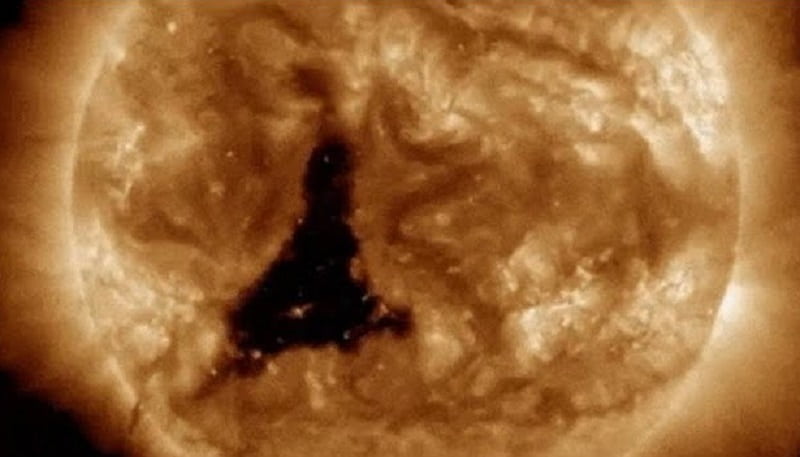Did you know that NASA researchers recently unearthed a colossal crater on the Sun's surface, spanning an astonishing width of approximately 800,000 kilometers? To put it into perspective, this mammoth crater could comfortably accommodate 60 Earth-sized planets within its expanse. Dubbed as the "Coronal Hole," this vast cavity harbors a significant phenomenon: solar winds emanating towards our planet. Such an occurrence poses a potential threat to our radio and satellite communications infrastructure. Due to its effect, the sky may experience a brilliant illumination. The hole took shape near the sun's equator, catching the attention of astronomers worldwide.
Coronal holes manifest as shadowy regions within the solar corona when observed in extreme ultraviolet (EUV) and soft x-ray solar images. Their darkness stems from being cooler and less dense compared to the surrounding plasma, denoting areas characterized by open, unipolar magnetic fields.
The sudden and dramatic expansion of this celestial hole raises alarms among scientists, primarily due to the substantial radiation emissions it emits. This radiation influx could disrupt GPS systems and wireless devices, amplifying concerns regarding potential geomagnetic storms on Earth. These storms, in turn, could directly impact the Earth's magnetic field, potentially resulting in radio blackouts across the globe.
Understanding the Coronal Holes
A coronal hole is an area on the Sun's corona where the magnetic field is open to interplanetary space, allowing high-speed solar wind to escape. These regions appear darker in images of the Sun because they have lower density and temperature compared to the surrounding areas. Coronal holes are typically seen at the Sun's poles but can also occur at lower latitudes as the Sun's magnetic field undergoes changes during its 11-year solar cycle.
The solar wind emanating from coronal holes can affect space weather, leading to geomagnetic storms and auroras when it interacts with Earth's magnetosphere. Studying coronal holes helps scientists understand the Sun's magnetic activity and its influence on the solar system.
What Lies Within the Coronal Hole?
The enigmatic nature of coronal holes on the Sun has long intrigued scientists, sparking a quest to uncover the secrets hidden within these mysterious regions. As vast voids in the Sun's outer atmosphere, coronal holes present a stark contrast to the surrounding luminous corona. Yet, within these seemingly desolate expanses, a dynamic interplay of magnetic fields and solar winds unfolds, offering tantalizing clues about the inner workings of our nearest star.
At the heart of the coronal hole mystery lies the question: What lurks within these darkened realms? Observations reveal that coronal holes are gateways through which the Sun releases streams of charged particles, known as solar wind, into space at heightened speeds. The magnetic fields within these regions are open, allowing solar material to flow freely into the cosmos. This relentless outflow shapes the solar wind's characteristics and influences space weather phenomena, from geomagnetic storms to the mesmerizing auroras that dance across Earth's skies.
Moreover, recent advancements in solar imaging and space-based observatories have unveiled intricate structures and dynamic processes within coronal holes. Intriguing features such as coronal jets, small-scale eruptions, and transient phenomena hint at the complex dynamics occurring within these enigmatic domains. Scientists endeavor to unravel the mechanisms driving these phenomena and their implications for our understanding of solar activity and its impacts on the solar system.
Furthermore, studies of coronal holes provide crucial insights into the Sun's magnetic field dynamics and its role in shaping the solar atmosphere. By probing the magnetic topology within these regions and monitoring their evolution over time, researchers aim to elucidate the mechanisms governing solar variability and its influence on Earth and other planets.
In the ongoing quest to unlock the secrets of coronal holes, interdisciplinary collaborations and cutting-edge technologies continue to illuminate the intricate tapestry of solar phenomena. With each new discovery, scientists move closer to unraveling the Great Sun Mystery, peering into the depths of these cosmic gateways to uncover the hidden forces that shape our solar neighborhood.













0 comments:
Post a Comment